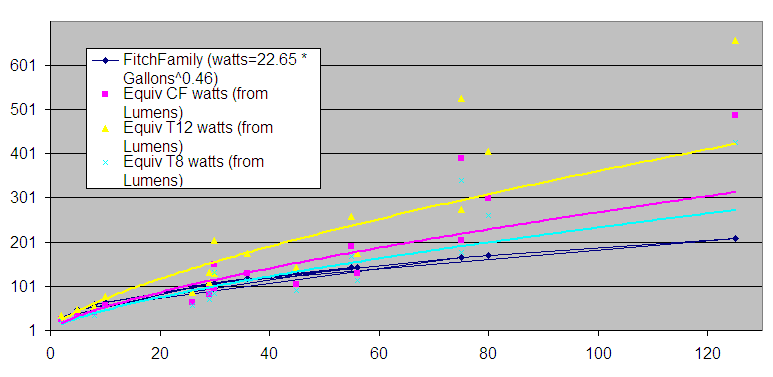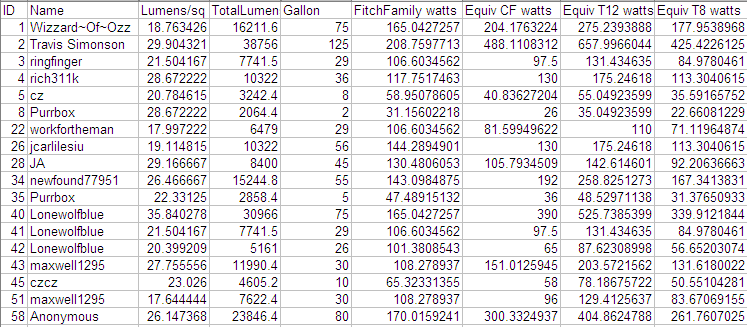travis simonson said:
Dang Joe

*dreams of lumens spinning in my head*
That statistical analysis goes well beyond me. Nice work man

Yes, lots of work, but to what end? What is really gained here in practical application?
You have a number of issue to overcome here with this and it's far from a simple method.
While many have poo pooed on the watt/gal rule, I've never found it to fail after keeping plants as the main focus for 15 years now.
Not once.................
Most of the issues revolve around the aquarist not having enough CO2/nutrients, more light can help in some cases where these are limiting, but generally not.
I've had deep tanks, I've used normal T12's, T5's, PC, MH, MV and probably more different types of lighting than most anyone here.
Incadescent light is another matter, but MH and FL's hold up very well, there is no plant I cannot grow in almost any reasonable sized tank, even some of the deeper ones.
I've grown nice Gloss at 24-28" deep tank with 1.5-2.1 w/gal of normal FL's with a reflector.
Many like to claim it needs high light etc, this is not true.
While all the analysis is interesting, and I've seen folks try and revamp the w/gal rule and make all sorts of claims about it, most of these same folks should put their efforts into CO2/Nutrients and they will no longer have such issues with lighting.
Here's why:
Plants grow do not on light alone.
Now read that again and 5 more times.
Now think about it.
Why might that statement greatly influence what you may think about lighting when I find it(w/Gal) so flexible?
Because plants require light and CO2 and nutrients to grow well.
If the CO2 and nutrrients are in good shape, then the plant can fully maximize the light available.
This has been shown in a number of studies relating CO2 use and light as well as nutrient availability and location.
So if you have not mastered CO2.nutrients very well, and have been able to definitively rule these oyut as potentially limiting factors, then the light issue is confounded by the other interactions like nutrients/CO2.
Given that CO2 is nearly 95% or more of all algae related issues I field, rather than light, the likelyhood of these other issues being overlooked with respect to light is extremely high.
Fun theory, don't get me wrong, but there are other issues going on here that have not been addressed well.
When folks haggle over lighting and other similar issues, they need to be able to rule out these other confounding factors.
You need to be able to fully master each thing/verify it, that influences growth before you can go it and test something adequately.
Most intermediate and newbies don't have a handle on that yet so they run from one topic to the next without learning step wise in search of that silver bullet, therein lies the danger. They get confused and spend time on other things that are often not nearly as relevant.
Neat spreadsheet though.
Regards,
Tom Barr


